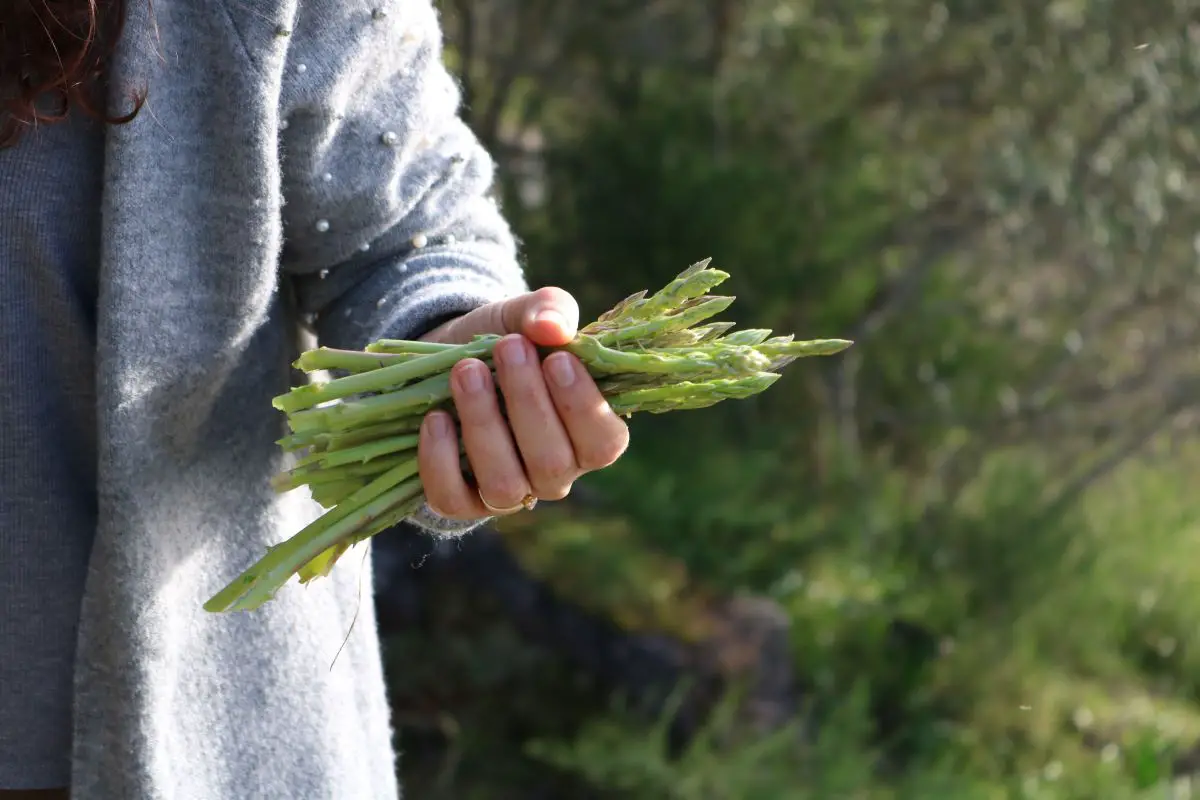Learn how to grow asparagus in this step by step guide. Whether you are starting it from seed, or with bareroot, this guide will help you with everything you need to know, such as how to plant asparagus, when to plant it, how to provide it with proper nutrients, and how to harvest it.
Disclosure: This post contains affiliate links. As an Amazon Associate I earn from qualifying purchases.
How to Start Asparagus From Seed
Growing asparagus from seed is super easy. However, it does require 1 extra step that most plants do not, and that is stratification.
Stratification Process
Asparagus can grow from zones 3 to 8. So it is a super hardy perennial. The plant stays dormant during the winter season, and comes back during the spring as the temperatures warm up.
Even though asparagus is a hardy perennial, it does not mean that it is frost hardy. The new shoots are very tender and can be easily damaged by frost. While the more established ferns can withstand some light frost.
During the summer season, the ferns develop seeds. Those seeds stay on the fern until they mature. Once mature, Some pop out of their pods, and some stay in their pods.
Once frost comes, the ferns die back. Both the seeds that dropped to the ground, and the seeds that remained in their pods get exposed to the cold winter temperatures.
Once spring comes back again, you cut the dead ferns back. Some more seeds fall onto the ground. You step on it, and drive it into the soil, unknowingly.
As temperatures warm up, new asparagus seedlings begin to sprout from the seeds that where dropped on the ground from the previous season, and from the spring clean up.
These seeds have been exposed to cold temperatures all winter long. This is known as stratification.
Many perennial plants that live in cold environments go through the same process.
When you purchase seeds, these seeds have been harvested before they were exposed to any cold temperatures. This stratification process is necessary for these perennials, and asparagus is one of those perennials that require stratification.
We can mimic this process of stratification by placing the seed packet in the fridge. I place mine on the lower shelf of the fridge door.
You can allow this process to take place for 2 to 6 weeks.
Without stratification, asparagus can be very difficult to germinate. However, the stratification process makes asparagus germinate in just a few days and gives you a 90% guarantee that your seeds will germinate.
Seed Starting Asparagus
Once you are ready to plant, remove the seeds from the fridge.
- Use an organic seed starting mix because seed starting mixes are formulated with the proper nutrients that seedlings require, and they are light and fluffy allowing your seedlings to root in easily, and germinate easily.
- Moisten your seed starting mix with warm water before planting in it. The mix should be moist, hold together when pressed, fall apart easily when you let go, and not muddy or dripping wet.
- Place the seed starting mix into a seed starting tray. Because asparagus has, deep roots you can use this root trainer seed starting tray. It comes with a humidity dome. The humidity dome helps the seeds to germinate quicker, and prevents the soil from drying out too quickly. Asparagus has deep roots, so a seed starting tray with space for deep roots is perfect for it.
- Plant the 2 seeds in each cell about 1/4 to 1/2 inch deep. Cover seeds with the seed starting mix.
- Once all the seeds are planted, cover with the humidity dome to ensure that the soil stays moist. Do not allow the soil to dry out, otherwise the seeds will die.
- Once the seeds begin to germinate, place the seedlings under a grow light, or in front of a south facing window. Checkout How to Start Seeds Indoors to see how you can make a DIY Grow Light System.
- Once all the seeds have germinated, remove the humidity dome, and keep the soil moist.
- You can begin to fertilize seedlings once they develop their ferns, but not at the shoot stage. Fertilize with an organic liquid fertilizer at half strength, or at the manufacturer’s recommended amount for seedlings.
- Once seedlings develop ferns, and establish their roots, they are ready to be transplanted into the ground.
How to Plant Asparagus Seedlings in the Ground
Plant asparagus in the ground when they are about 8 to 10 inches tall, and they had developed their ferns.
- Plan on planting asparagus seedlings in the ground after your last frost date, or when all danger of frost is gone. You can find out what is your last frost date by typing your zip code or town, and state name into google plus the words “last frost date”. Many search results will appear showing you the last frost date of the main city that is closest to you.
- Space asparagus plants between one to two feet apart.
- You can either dig an 8 inch deep hole for each asparagus plant, or dig an 8 inch deep trench for all the plants that you are planning on planting in a row.
- Space rows 4 to 6 feet apart.
- Fertilize the soil in the holes or trench with some organic rock phosphate, potash, and blood meal, or with an all purpose organic fertilizer.
- Place the developed asparagus seedlings in the hole or trench that you dug.
- Gently hold the ferns straight up to prevent them from braking or bending. Cover the ferns with some soil until about one to two inches of the fern are sticking out of the dirt. Do not fully cover the asparagus plant because they need the light to photosynthesis.
- As the plant grows, continue to cover it with soil, leaving about 1 to 2 inches exposed, until the soil level reaches the top surface of the hole/trench that was dug.
- After planting, Water the soil around where you have planted the asparagus ferns. Continue to water your ferns throughout the summer, whenever they need it. Do not allow the soil to fully dry out.
- Once the plant is extending about 6 to 8 inches above the soil, you can cover the soil around it with some mulch to retain moisture in the soil, and protect the root and young shoots of the plant from frost.
- Keep all asparagus shoots attached to the plants for the first 2 to 3 years. At this stage the plant needs all its shoots to help develop its roots.
- Keep the area well weeded to prevent competition. Young asparagus seedlings cannot tolerate weed competition. They will not thrive in such conditions.
How to Plant Asparagus From Bareroot
Planting asparagus bareroot is similar to planting it as a seedling.

- Plan on planting asparagus seedlings in the ground after your last frost date, or when all danger of frost is gone. You can find out what is your last frost date by typing your zip code or town, and state name into google plus the words “last frost date”. Many search results will appear showing you the last frost date of the main city that is closest to you.
- Dig a 1 foot wide and 8 inch deep trench where you are planning on planting your asparagus ferns.
- Space rows 4 to 6 feet apart.
- Fertilize the soil in the trench with some organic rock phosphate, potash, and blood meal, or with an all-purpose organic fertilizer.
- place each root into the trench with the crown facing up. Make sure to spread out the roots a bit so that they are not all clumped up together in one spot. The space between each bareroot should be between one to two feet apart.
- Cover the roots with some soil to just below the crown. As the plant grows, you can come back and continue to cover it with some soil leaving about 1 to 2 inches of the plant exposed, until you reach the top level of the trench.
- Once the plant grows about 6 to 8 inches above soil level, you can cover the soil around it with some mulch to protect the young asparagus shoots, and roots, from frost.
- Lightly moisten the soil around the asparagus roots after planting. Keep the soil lightly moist around the roots, but not soaking wet, to prevent rot.
- You can begin to gently water the asparagus after it grows a few shoots. Do not over water it. Over watering will cause the root to rot.
- Asparagus roots should not be harvested during the first year of planting. The plant needs all its shoots during its first growing season in order to photosynthesis and establish its roots.
- Keep the area well weeded to prevent competition.
Does Asparagus Regrow After Cutting
Asparagus is a perennial plant that will grow year after year. It can live for many years to come. As you harvest asparagus shoots, new shoots will sprout from the crown of the plant. By the end of the harvest season, Asparagus shoots should be left to grow to allow the plant to draw energy and store it in its roots.
Does Asparagus Need Full Sun
Asparagus, like most plants, thrives in full sun. It requires at least 6 to 8 hours of sunlight. Plant asparagus in a full sun location in a well draining fertile soil.
Asparagus can grow between 6 to 8 feet tall. So be sure to plant them in the back row where they will not block the sun for other plants.
If you plant asparagus in a shadier location, the plant will not grow to its full potential. You might get less asparagus shoots, and a shorter plant.

What Is the Best Fertilizer for Asparagus
Asparagus is a plant with fairly large roots. An established asparagus root can grow between 10 to 15 feet deep and 5 to 6 feet wide! Keeping the soil healthy and well fertilized is important for asparagus root health.
Asparagus can survive in slightly acidic soil, but prefers less acidic soil such as 6.8. The ideal PH levels for asparagus according to the University of Michigan is a a PH of 7 (neutral).
Asparagus grown in a more acidic soil tends to be vulnerable to Fusarium root rot which is caused by the Fusarium fungi. This can eventually kill the plant.
Asparagus needs phosphorus, potassium, and nitrogen. Phosphorus and potassium are responsible for root growth and health, while nitrogen gives the ferny growth vigor and health. Provide the plant with more phosphorus and potassium than nitrogen.
With that said, other nutrients are also needed such as magnesium and calcium. To ensure a fertile soil and plant, you can provide the soil with a well balanced organic fertilizer.
When Should I Burn My Asparagus
According to the University of Minnesota, Burning asparagus can eliminate the asparagus beetles. Asparagus beetles hide in the old fern growth of the plant and can decimate a crop if left untreated.
Burning old ferns usually should be done in late winter/early spring, before the plant begins to put out new growth.
If the plants are around any structures or plants that can be damaged by burning, or burning cannot be done in a controllable matter, it is best to avoid it. In that case, bag the old growth and tie it at the bottom of the fern close to the surface of the ground. Cut the ferns, empty the bags in a safe burning location, and burn them at the said safe location.
Asparagus beetles feed on young asparagus spears and cause browning or spotting. You can find out more about asparagus beetles at the University of Minnesota Extension.
Does Asparagus Need to Be Staked
If asparagus ferns have thin stems, or if you live in a very windy area, it is best to stake them.
You can place some T posts on both sides of the asparagus row. Tie a string that goes along each T post row that connects to each T post at 3 feet high, and one at 6 feet high to provide support for the plants.

How and When Do I Harvest My Asparagus
Harvest asparagus in early spring when the shoots are young and tender, and are about 6 to 8 inches high. You can either snap the asparagus by hand, or use a knife and cut the spears just below the surface of the ground.
Once asparagus develops leaves, it is then too tough to eat.
Continue to harvest asparagus spears until late spring/early summer. Make sure to leave at least 2 to 3 spears by the end of the harvest season to make sure that the plant can photosynthesis and store sugars in the root for the next growing season.
How Do You Grow Thick Asparagus
Asparagus comes in both male and female plants. Female plants are more slender, while male asparagus tends to be thicker. Growers prefer male asparagus for that reason, and because it tends to put out more spears during harvest season.
Female plants develop seeds during the growing season, and can cause an invasion of asparagus plants if not controlled, or having the seeds harvested before they drop to the ground. This is another reason why growers prefer male plants, so that they can have a more controlled growing area.
Asparagus requires a good amount of water during the growing season, since the plant contains a large amount of water in its shoots, and ferns.
Having good nutrients, and a fertile soil is also a big element in growing thick asparagus. You can fertilize the soil in early spring with some phosphorus, potassium, and nitrogen, or with an all purpose organic fertilizer.
Sign Up to Our News Letter!
Pin This Post!

More Gardening and Recipe Related Topics
Salmon Recipe With Soy Sauce In The Oven
Gluten Free Mediterranean Eggplant Stew With Chickpeas
Shop This Post
root trainer seed starting tray
all purpose organic fertilizer
Tell Us What You Think!
Whether you are growing asparagus from seed or from bareroot crowns, the key is to be patient, but you will soon reap the rewards of your patience for years to come. Asparagus continues to live up to 30 years if cared for properly. It is a wonderful addition to any dish whether eaten raw, steamed, sautéed, grilled, or baked.
Tell us your favorite way of eating/preparing asparagus! Are you currently growing asparagus? What has your experience been so far in growing it? Is this your first time growing asparagus? Ask any question in the comment section below, and maybe I, or another experienced, helpful gardener can help you by answering your questions in the comment section.
Disclosure Policy
Disclosure: Some of the links in this post are “affiliate links”. This means if you click on a link and purchase the item, I will get an affiliate commission. It will not cost you any extra money, but it will help me pay for this website, and it will help me to keep providing you with helpful articles such as this one. I only post links to products that I personally use and love, or to products that I wish I could have, and that could be of value to you. The information that I provide you with, my blog, videos, and many resources are free.





Be the first to reply